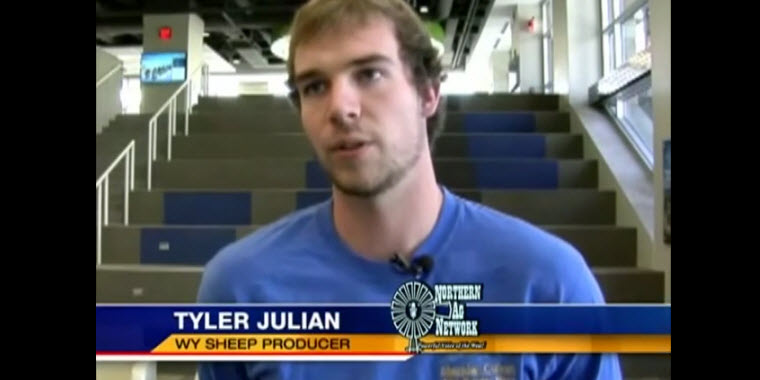BOZEMAN – Farmers and ranchers have long been in search of ways to limit the need for tillage and chemical herbicides on farmland, and two researchers in Montana State University’s College of Agriculture are working on a project that may provide a solution.
With help from the Western Sustainable Agricultural Research and Education program, which is being hosted by MSU until 2023, Devon Ragen, a research associate in the Department of Animal and Range Sciences, and graduate student Trestin Benson have conducted two years of tests on local farms to see if grazing sheep on vegetable or cover crop plots can help improve soil health while reducing artificial inputs to the soil.
“We’re looking at differences in microbial communities in the soil and nutrient profiles,” said Ragen. “We use sheep for a pre-graze before seeding to clean up all the weeds instead of having to spray or till it up.”
Tillage, she said, is one of the biggest detriments to organic farmers. While useful for turning fertilizer and plant matter into the soil, it also promotes wind erosion by making the upper layers of earth easier to blow away. If incorporating sheep into a farming system results in less need for tillage, it would be a win for farmers. Ragen and Benson have partnered with Strike Farms in Bozeman, 13 Mile Lamb and Wool in Belgrade, and Black Cat Farm in Boulder, Colorado; all three farms volunteered to test out their theory and allow sheep to graze their vegetable fields.
Those tests have shown that when sheep were allowed on cropland to eat weeds and leave manure and urine — natural fertilizer — behind, it reduced the need for tillage 60 percent of the time. However, having animals in a vegetable field carries with it the concern of the sheep compacting the soil too much and interfering with seeding and growth. But fortunately, Ragen and Benson haven’t found it to be a problem in their farm tests, which is more good news for producers.
“We looked at these grazed organic fields and compared them to tilled organic and chemical fields, and we’re not really seeing a big difference in terms of compaction,” Ragen said. “From a farmer’s perspective, it’s not really a detriment to have sheep out there, and we’re actually seeing higher nitrogen in the soil after the sheep have grazed, so that’s less fertilizer they have to apply and less cost in actually purchasing the fertilizer.”
One of the upsides to the project is that it doesn’t require the producer partners to change anything in their systems — simply allow Ragen and Benson to take soil samples before and after sheep are allowed grazed on the plots. They do much of their work with a part of the MSU-owned flock of sheep that lives at Fort Ellis Research Farm. For Benson, who began working with Ragen in 2017 while finishing her undergraduate studies, the project has provided an opportunity to adapt based on farmer interests.
“When it started out, we thought it was going to be a cropping systems project,” Benson said, but farmers were keen to test the ideas in the context of vegetable farming. “It’s evolved into something a little different and unique that way. It’s been fun working with the farmers and all their different systems, which gives an interesting perspective.”
The SARE program, which focuses on supporting projects dedicated to furthering sustainable agriculture, is the nation’s top producer-led grant program in the field. MSU was selected in 2018 as the western regional host for the program, which will bring more than $27 million in grants and operational costs to MSU researchers and graduate students over the next five years. Ragen and Benson’s project received a SARE grant in 2017 and they will dedicate the final year of that funding to producing write-ups, tip sheets and videos for producers. They’ll also host a workshop at Towne’s Harvest Farm in Bozeman on July 25 from 9 a.m. to noon for anyone who wants to learn more about the project and its potential applications.
They hope that their research will offer farmers and ranchers an added level of comfort in pursuing livestock-cropland partnerships in a real-life context. The whole point of their work has been to test a practical option for Montana agriculturalists, refine the process and provide reliable information to communities around the state and beyond.
“As researchers I think it’s really important that we can do all the trials and let them know what works and what doesn’t so they can feel a little more comfortable going out there and trying it themselves,” said Ragen.
###
Article by: Reagan Colyer
Montana State University News Service


